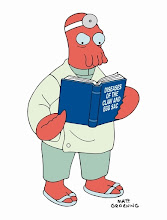I plan to do a series of posts on the anatomy, physiology and common pathologies of the athlete's shoulder. This first one will cover the articulations, or movements, that the shoulder is capable of. First it is necessary to cover briefly the anatomy of the shoulder complex, as this better aids us in understanding how different movements are accomplised.
The shoulder girdle consists of three bones: the scapula (shoulder blade), the clavicle (collarbone) and the humerus (long bone of the upper arm).
The scapula and the humerus articulate at the glenohumeral joint. The clavicle meets the acromion process of the scapula at the acromioclavicular joint, above the glenohumeral joint. The medial end of the clavicle forms the only bony connection of the shoulder girdle with the body, meeting the sternum at the sternoclavicular joint. Posteriorly, the scapula overlies the thorax, forming the scapulothoracic joint. There is no direct relation of the scapula to the ribcage, the scapula instead gliding over the surface of the body wall suspended by a complex network on muscles.
The anatomy of the shoulder girdle makes the broadest range of movements possible, at the expense of stability (compare with the hip, where the pelvic girdle bones are fused and capable of only very limited movement). The glenohumeral joint has been likened to a golf ball sitting on a golf tee, making the support of various muscles critical to the effective functioning of the joint. Similarly, the scapula can move extensively across the body wall to further the range in which the arm can move. The images above and below illustrate the relationships of the bones which make up the shoulder girdle.
The movements of the shoulder can be subdivided into movements of the humerus and movements of the scapula and clavicle. It must be borne in mind that most movements that we perform in the gym and in daily life involve a combination of both humeral and scapula movement. Indeed, effective functioning requires the two to move together effectively, a phenomenon known as scapulohumeral rhythm. Scapular dyskinesis, faulty scapulohumeral rhythm, may be responsible for common shoulder overuse injuries.
This first video shows the isolated movements of the Scapulae. In order, these are:
- Elevation
- Depression
- Protraction
- Retraction
- Upward rotation
- Downward rotation


The final two, upward and downward rotation, are difficult to demonstrate without moving the humerus as well. They may also at first glance appear identical to Elevation and Depression, but as the image shows, the scapula in fact rotates to point the glenoid upwards.
The next video shows the movements of the humerus at the glenohumeral joint. These are in order:
- Flexion
- Extension
- Abduction (aB)
- Adduction (aD)
- External rotation in adduction
- Internal rotation in adduction
- External rotation in abduction
- Internal rotation in abduction
Combinations of scapular and humeral movements accomplish the movements that we use in the gym. For example, the overhead press involves scapula upward rotation, some protraction and elevation, and humeral flexion and some external rotation. Looking at the images and videos above can aid in understanding how this happens. Another is example is a horizontal row, which involves scapula retraction, depression and humeral extension.
The best way to understand these movements and understand your body better, is to attempt these movements in isolation yourself. It is a subject for another article, but failure of proper synchronous contraction of various muscles during different scapular and humeral movements can result in some common and frustrating shoulder problems. Just learning how to accomplish the various different movements, focusing on the different muscles contracting in each one, can go a surprisingly long way to improving shoulder issues.
In the next article, I will deal more with the muscles that accomplish the articulations described above. Common dysfunctions and their remedies will follow.




No comments:
Post a Comment